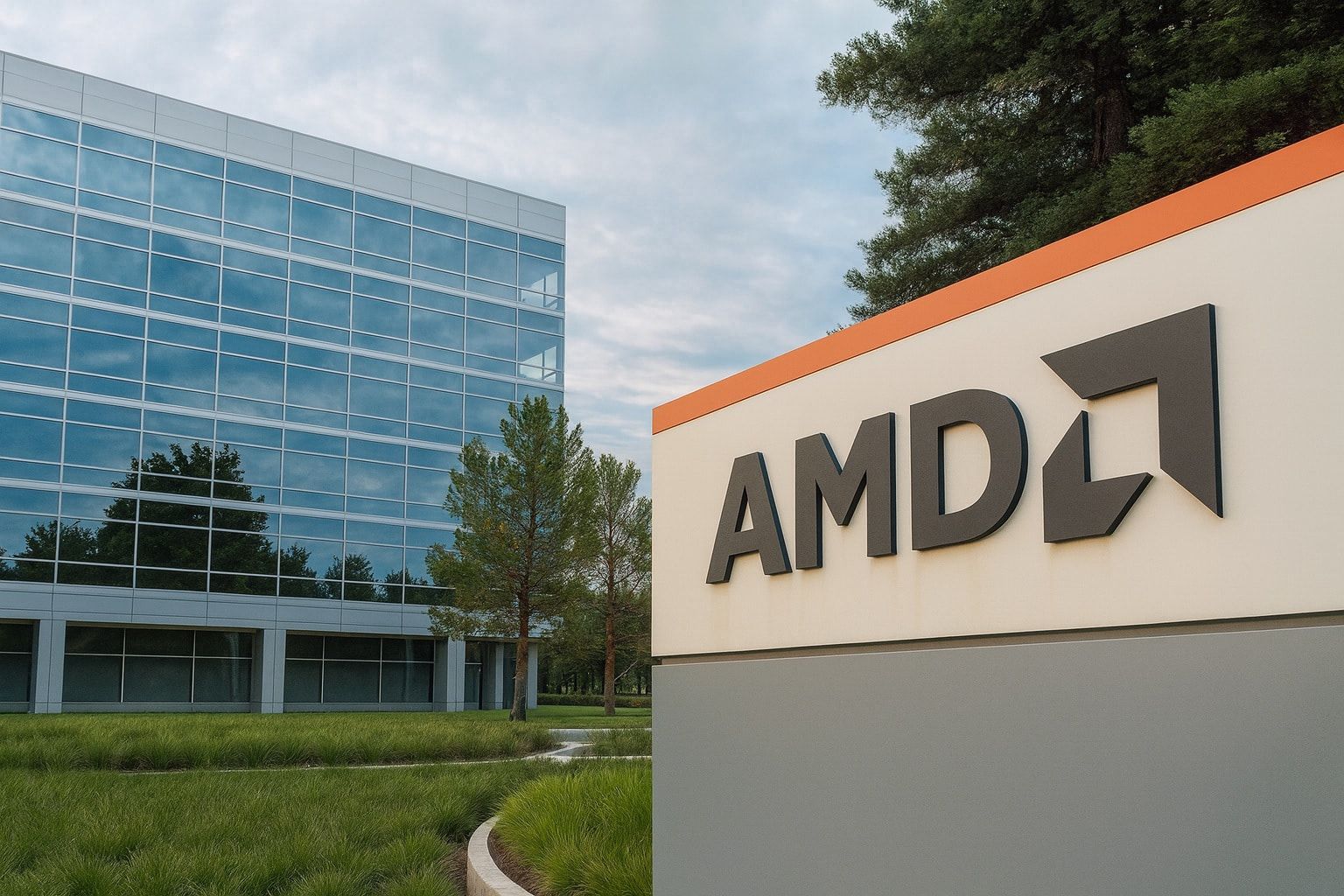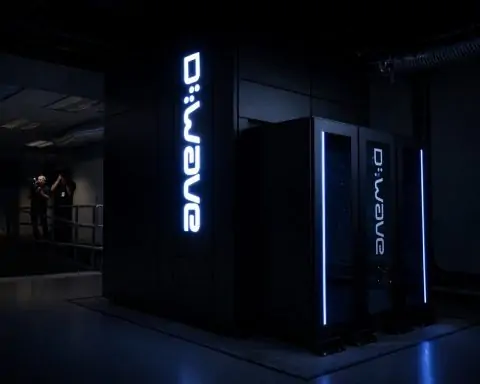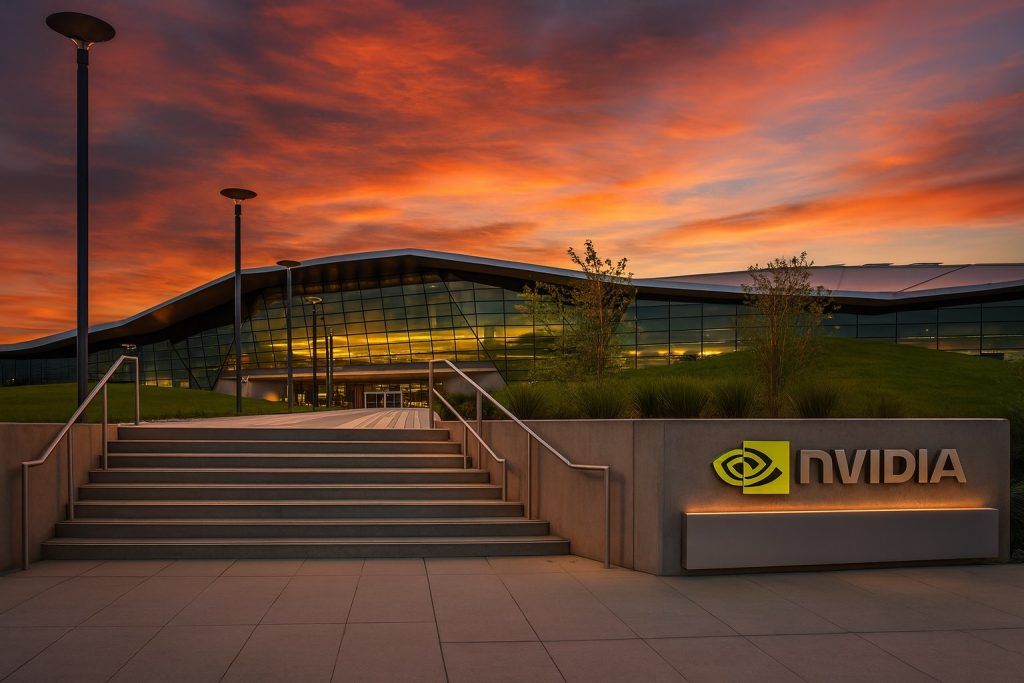- Record High: Advanced Micro Devices (AMD) stock surged to an all-time high around $253 per share after jumping 7.6% in one day on IBM’s quantum computing news [1]. The chipmaker’s shares have now doubled in 2025 (roughly +110% year-to-date) amid a broader AI-fueled rally [2].
- AI Mega-Deals:OpenAI & Oracle partnerships have supercharged AMD’s growth story. In early October, AMD struck a landmark deal to supply 6 gigawatts of AI chips to OpenAI (maker of ChatGPT) – with OpenAI even getting warrants for a 10% stake in AMD [3] [4]. Shortly after, Oracle agreed to deploy 50,000 of AMD’s upcoming MI450 GPUs in its cloud, showcasing confidence in AMD’s new “Helios” AI systems [5] [6]. AMD expects these wins (and related orders) to generate over $100 billion in new revenue over four years [7], a massive boost compared to $25B annual sales in 2024.
- Wall St. Bullish:Analysts are raising targets and ratings en masse. About 65% of analysts now rate AMD a “Buy,” up from ~50% earlier [8]. Price forecasts have been hiked into the $250–$310 range – e.g. BofA’s Vivek Arya upped his target to $300 [9], and HSBC to $310 – citing AMD’s strengthened outlook thanks to the OpenAI/Oracle deals. Wolfe Research even projects AMD’s earnings could exceed $10 per share by 2027 if execution stays on track [10].
- Technical Signals: After a 56% surge in the last month alone [11], AMD’s momentum indicators are flashing hot. Its 14-day RSI is above 70 (overbought territory) [12] and shares trade far above their moving averages. The stock’s valuation – about 40× 2026 earnings (trailing P/E >100) – is steep [13], which “leaves little room for error” if growth falters. Chart analysts peg initial support around $230–$240 and resistance near $260–$270, suggesting a breather or pullback is possible after the parabolic run [14].
- Nvidia & Intel in Focus:NVIDIA still dominates with ~90% of the AI GPU market [15] and a formidable software ecosystem (CUDA), so AMD’s challenge is steep. NVIDIA even made the unusual move of buying ~4% of Intel for $5 billion to co-develop future chips [16], underscoring how competitors are aligning. Intel, meanwhile, is trying to catch up – it plans a 2026 “Crescent Island” AI chip [17], but analysts quip that “Intel is late to the party” after years of delays [18]. AMD is countering with an “open” approach (combining its Instinct GPUs, EPYC CPUs, and open-standard Helios systems) that has won marquee customers, but it must execute flawlessly to close the gap [19].
- Macro & Policy Wildcards: AMD’s ascent comes amid tech euphoria and easing economic fears. Cooling inflation (Sept CPI +3.0% vs 3.1% expected) has bolstered bets on Fed rate cuts, lifting high-growth stocks like AMD [20] [21]. The Philly semiconductor index is up ~32% this year [22]. However, government actions add uncertainty: new U.S. export curbs on advanced chips to China hit AMD earlier in 2025 – it took a $800 million charge after the U.S. banned its MI308 AI GPUs to China [23] [24]. (China made up ~24% of AMD’s sales [25].) While some restrictions have since been eased, trade tensions and regulations remain a key risk for all chipmakers.
Red-Hot October: From AI Deals to a Quantum Leap
It has been a blockbuster October for AMD stock. The rally kicked off when AMD announced a multi-year AI chip deal with OpenAI on Oct. 6, sending shares up over 34% in one day [26] – their largest single-day gain since 2016. Under that transformative agreement, OpenAI will purchase hundreds of thousands of AMD GPUs (≈6 GW of compute) starting in late 2026, and notably secured the right to buy up to 160 million AMD shares at $0.01 each as part of the partnership [27]. Analysts called the OpenAI deal “certainly transformative” and “a major vote of confidence in AMD’s AI chips and software,” even if it won’t dent NVIDIA’s dominance in the near term [28]. “AMD has really trailed Nvidia for quite some time, so I think it helps validate their technology,” noted Leah Bennett, chief investment strategist at Concurrent Asset Management [29]. In other words, the market leader NVIDIA still sells every AI chip it can make, but AMD is now firmly on the radar as a viable alternative.
Just a week later, AMD scored another big win with Oracle. On Oct. 14, Oracle announced it will deploy 50,000 of AMD’s next-gen MI450 graphics processors in new cloud “AI superclusters,” slated to come online in late 2026 [30] [31]. These supercomputers will use AMD’s full-stack “Helios” platform – blending AMD’s Instinct accelerators, EPYC “Venice” server CPUs, and high-speed interconnects – in a move to diversify beyond NVIDIA’s dominant systems [32] [33]. Oracle’s endorsement further validated AMD’s data-center tech. AMD’s CEO Dr. Lisa Su touted these mega-deals as “truly win-win, enabling the world’s most ambitious AI build-out,” and AMD’s finance chief said the partnerships should deliver “tens of billions” in revenue and be “highly accretive” to earnings over the coming years [34] [35]. In total, AMD’s management estimates $100 billion+ in additional revenue over four years from the OpenAI and Oracle engagements (an enormous sum, given AMD’s 2024 revenue was ~$25 billion) [36].
The stock market’s reaction was swift and extreme. AMD’s share price rocketed from the $160s before the OpenAI news to over $230 by mid-October [37]. It briefly touched $238 (a new peak at the time) intraday on Oct. 15 [38]. After a short breather, yet another catalyst arrived at month’s end: IBM’s quantum computing breakthrough. On Oct. 24, IBM revealed that a critical quantum error-correction algorithm can run on a conventional AMD chip (FPGA) in real time – a significant milestone toward practical quantum computers [39] [40]. This unexpected news sent IBM’s stock up 7.9% and AMD up 7.6% in the same session [41], propelling AMD to fresh record highs around $252.92 at the close [42]. Broader bullish sentiment amplified the spike: that morning, the U.S. reported cooler-than-expected inflation, stoking hopes of imminent Fed rate cuts [43]. By the end of last week, AMD’s market capitalization topped $350–$380 billion [44] (crossing the $400B mark on some measures) – making it the world’s third-largest chipmaker by market value, behind only NVIDIA and Intel [45]. All told, AMD’s stock is up roughly 90–110% in 2025 [46], dramatically outperforming the Nasdaq’s ~30–40% gain [47]. This breathtaking run has retail investors and tech watchers asking: Can AMD keep climbing, or is this as good as it gets?
Wall Street Analysts: High Hopes – and Some Caution
The wave of good news has Wall Street analysts scrambling to upgrade their outlook on AMD. The consensus view on the stock has shifted decisively bullish in recent weeks. According to TipRanks data, 39 analysts now cover AMD with 29 Buys, 10 Holds, and 0 Sell ratings, giving it a “Moderate Buy” overall [48]. That is a far more bullish skew than earlier this year. The average 12-month price target now sits around $249–$250 per share [49] – roughly in line with the current price, which suggests the stock’s recent surge has caught up to many prior targets. However, top analysts are hiking their targets into new territory: the highest now reach $300+ [50].
For instance, Bank of America’s Vivek Arya raised his target from $250 to $300 (maintaining a Buy), citing newfound “visibility” from AMD’s OpenAI and Oracle deals and the company’s expanding role in AI infrastructure [51]. HSBC analysts likewise set a street-high $310 target [52]. Wolfe Research initiated an Outperform with a $300 target, projecting AMD could achieve >$10 earnings per share by 2027 if it capitalizes on these opportunities [53]. And on Oct. 15, Wedbush’s Matt Bryson bumped his target to $270 (from $190) after AMD’s Oracle win, highlighting the Helios platform’s promise in next-gen AI workloads [54]. This growing bullish chorus reflects a view that AMD’s fortunes have fundamentally improved – the company has “table stakes” in the AI race now, whereas before NVIDIA was the only game in town.
That said, not everyone is swept up in euphoria. A few voices of caution point out that AMD’s stock price already bakes in years of future growth, leaving less margin for error. For example, Kevin Cassidy of Bernstein (formerly Rosenblatt) reiterated a neutral stance (Market Perform) with a $200 price target even after the OpenAI deal [55]. Cassidy was surprised AMD gave up a potential 10% equity stake to OpenAI so cheaply (essentially issuing deeply discounted warrants), but acknowledged it was a strategic move to gain AI market share given AMD’s solid balance sheet [56]. While optimistic about improving PC and server trends and AMD’s overall outlook, he warned that the market may be overly optimistic about how fast AMD can ramp up AI revenue through 2027 [57]. In other words, AMD still has to prove it can execute on these mega-deals and actually grab meaningful AI market share from NVIDIA. If anything goes awry – product delays, yield issues, softer demand – the stock could correct quickly.
Even some bulls acknowledge the lofty valuation demands flawless execution. “At current levels, the valuation is very high… any slowdown and you’ll see profit-taking,” one strategist noted [58]. The consensus 12-month target of ~$250 implies analysts see limited upside near-term after the huge rally [59] – essentially, the stock might need to “grow into” its valuation. Still, with roughly two-thirds of analysts rating AMD a Buy now [60], Wall Street’s base case is that AMD will deliver on the hype. Many are anticipating strong quarterly results and guidance updates (discussed below) to further justify the optimism.
Competitive Landscape: AMD vs. NVIDIA vs. Intel
A big part of AMD’s investment thesis hinges on how well it can compete against its much larger rivals in the semiconductor arena – most notably NVIDIA in artificial intelligence and Intel in CPUs (and now GPUs too). Each company has very different strengths and strategies, and recent developments have only intensified the competition.
NVIDIA – the AI titan: By all measures, NVIDIA remains the king of AI chips. Before AMD’s recent deals, NVIDIA commanded an estimated 90–95% share of the data-center GPU market [61], thanks to its industry-leading H100 and A100 AI accelerators and its deep software ecosystem (CUDA and AI libraries) that developers rely on. NVIDIA’s dominance is so entrenched that virtually every major AI initiative – from cloud providers to startups – has been built on NVIDIA hardware, and the company has been selling every chip it can produce. Analysts say AMD’s new partnerships are an encouraging sign, but “unlikely to dent Nvidia’s dominance” in the near term [62]. Indeed, OpenAI itself is hedging by working with both vendors: in September, OpenAI agreed to buy at least 10 GW of NVIDIA systems (with Nvidia investing $100 billion into OpenAI’s venture) – an even larger commitment than the AMD deal [63]. AMD’s strategy to challenge NVIDIA is to position itself as an “open” alternative to the NVIDIA ecosystem: AMD’s Instinct GPUs and ROCm software are open-platform, aiming to integrate easily with various CPUs and interconnects (e.g. its new open-standard Helios racks that companies like Meta and Oracle support) [64]. This appeals to big cloud customers who crave a second source of AI chips beyond NVIDIA. Still, AMD’s current AI GPU (MI300X) only launched recently, and NVIDIA is about to roll out its next-gen “Vera Rubin” GPU, keeping the pressure on. Bottom line: NVIDIA holds the high ground, but AMD is leveraging its Xilinx FPGA expertise and new GPU designs to carve a niche, and the OpenAI/Oracle wins suggest some cracks in NVIDIA’s armor (or at least, customers’ willingness to consider alternatives).
Intel – the longtime rival: AMD has been battling Intel for decades in the CPU arena, and that fight is evolving as both also push into AI accelerators. In traditional markets, AMD continues to chip away at Intel’s market share in PC and server processors. Despite Intel’s attempts at a turnaround under CEO Pat Gelsinger, Intel’s key businesses are still struggling – its latest earnings showed its data center and client computing groups are not yet back to growth, prompting observers to say “this fight is far from over” and Intel is “nowhere near a turnaround” in its core segments [65]. Bank of America’s Vivek Arya notes that AMD keeps gaining share in servers and PCs while Intel lags, partly because Intel has fallen behind in manufacturing technology (its delays on 7nm/5nm chips let AMD, which outsources to TSMC, leap ahead on performance) [66].
When it comes to AI chips, Intel is essentially starting from scratch. It had scrapped several GPU projects (like its “Falcon Shores” AI chip) in recent years, and only now is preparing a new data-center GPU called “Crescent Island” for 2026 [67]. That chip will focus on AI inference and power efficiency, but by 2026 both NVIDIA and AMD will likely be two generations ahead. One industry analyst dryly quipped, “Intel is late to the party,” reflecting sentiment that Intel missed the boat on AI and is playing catch-up [68]. In a surprising twist, NVIDIA and Intel have partnered up: last month NVIDIA agreed to invest $5 billion for a ~4% stake in Intel [69]. This deal, part of a co-development pact, suggests Intel will produce certain NVIDIA-chips (using Intel’s foundries) and NVIDIA will help Intel with GPU technology for PC and data center platforms. It’s an unusual alliance born out of mutual needs – Intel needs to stay relevant in AI where NVIDIA excels, and NVIDIA can benefit from Intel’s CPU and manufacturing capabilities [70]. For AMD, this means it faces a tag-team of the two giants in different ways: NVIDIA on one side, and Intel (with some NVIDIA backing) on the other.
Even so, AMD has some unique advantages. It is the only company besides Intel with a top-tier x86 CPU and high-end GPU portfolio under one roof. This allowed AMD to develop its accelerated platforms like the upcoming MI300A, which combines an EPYC CPU and GPU on the same package – attractive for AI servers. AMD is also integrating Xilinx’s FPGA tech (acquired in 2022) into adaptive AI chips. And unlike Intel’s closed ecosystem or NVIDIA’s proprietary software stack, AMD is evangelizing an open ecosystem approach. If large buyers like cloud providers demand more vendor diversity for strategic reasons, AMD stands to gain. But that will require AMD to flawlessly execute on product delivery and support; any stumble, and would-be customers will default to the safer NVIDIA option. In short, AMD has opened a door, but walking through it to truly challenge the incumbents will be the next big test.
Sky-High Valuation Meets Technical Test
With AMD’s stock nearly doubling in a few months, some investors are understandably nervous about the technical and valuation picture. The stock’s rapid ascent has pushed it into potentially overextended territory by several measures. As of this week, AMD’s 14-day RSI (Relative Strength Index) is hovering above 73 [71] – above the “70” threshold that typically signals an overbought condition. The shares now trade well above their key moving averages (for example, AMD is ~40% above its 50-day average, an unusually large gap [72]). Such momentum can certainly continue in a euphoric market, but “parabolic” moves often see corrections, and many traders wouldn’t be surprised by a bout of profit-taking or at least a sideways consolidation.
Valuation is the other concern. At ~$250+ per share, AMD is valued around 100 times trailing earnings and about 40 times projected 2026 earnings [73] – a rich multiple even for a high-growth tech company. By comparison, NVIDIA trades around 30× forward earnings, and the broader Philadelphia Semiconductor Index (SOX) has an average forward P/E in the 20s. AMD’s premium reflects the scarcity value of a credible #2 player in AI chips and the significant earnings growth expected to come. However, it also means the stock is priced for perfection. “AMD’s valuation leaves little room for error,” one analyst cautions [74]. If the company’s growth stumbles even slightly, the high-flying stock could see a sharp correction as valuations compress.
Key technical levels may offer clues to investor psychology. On the upside, if AMD can break decisively above the mid-$250s (its recent peak), technicians see room toward the $270–$300 range before the next major resistance [75]. That could be fueled by a blowout earnings report or other positive news. On the downside, initial support is around $230–$240 (a zone where the stock consolidated in October and which could now attract dip-buyers) [76]. Below that, the next strong support is around $210–$220, near the 50-day moving average and the zone of the early-October breakout. A fall back to $210 would be a ~17% drop from current levels – not inconceivable given the recent volatility. In summary, AMD’s chart is extended but not broken; it could go either way in the short term. Bulls are firmly in control, but any hint of bad news could test the stock’s resilience after such a steep run.
Macro Tailwinds and Regulatory Risks
AMD’s rise hasn’t happened in a vacuum – it’s been aided by a favorable macro backdrop in late 2025. U.S. economic data has been coming in Goldilocks-style for markets: growth is resilient but inflation is cooling, which is the perfect recipe for tech stocks. In October, the Consumer Price Index rose 3.0% year-on-year, slightly less than expected [77]. This eased worries about further Federal Reserve tightening. In fact, traders are now betting the Fed will start cutting interest rates in the coming months (possibly as soon as the next meeting) [78] [79]. Lower interest rates boost the present value of future earnings, which disproportionately benefits high-growth, high-P/E stocks like AMD. It’s no coincidence that as rate expectations have shifted dovish, Nasdaq and S&P 500 indexes hit record highs in late October [80], and semiconductor stocks rallied strongly (the SOX index jumped ~2% on Oct. 24 alone [81]). This rising tide has lifted AMD even higher on the momentum wave.
Another tailwind is the AI investment boom across industries. Companies in virtually every sector are pouring money into AI capabilities, driving extraordinary demand for advanced chips and cloud computing power. Big players like Microsoft, Google, Amazon are investing billions in AI data centers (often ordering both NVIDIA and AMD chips). Even non-traditional names – e.g. Bitcoin miners pivoting to AI workloads – have emerged, adding to demand [82]. This broad-based frenzy for AI has created a rising demand tide that benefits all leading chipmakers. As one market observer noted, we’re seeing a “self-reinforcing cycle: investor enthusiasm for AI is driving AMD and peers to new highs, which in turn feeds more hype about the AI boom” [83]. Of course, such frothy optimism can flip to fear just as quickly, but for now the trend is AMD’s friend.
On the policy front, however, AMD faces some challenges. The U.S.–China tech war has directly affected AMD’s business this year. In April, the U.S. government (under the Biden/Trump administration in 2025) expanded export controls on advanced semiconductors to China, aiming to block China’s access to cutting-edge AI chips. AMD confirmed that its upcoming MI308 GPUs fell under the ban, effectively shuttering sales of those chips to China without a special license [84]. China was AMD’s second-largest market (24% of revenue in 2024) [85], so the impact is significant. AMD said it expected to incur up to $800 million in charges (inventory write-downs and such) due to the new export curbs [86]. Rival NVIDIA, which sells even more to China, projected a whopping $5.5 billion hit [87]. These restrictions dragged both stocks down in April [88]. Since then, there have been some negotiations and adjustments – reports emerged over the summer that certain AI chip shipments might resume under revised rules or license fees [89], and as of October the U.S. was considering requiring chipmakers to pay a 15% royalty on China AI chip sales in exchange for export licenses [90]. It’s a fluid situation, but the risk of geopolitics is ever-present. Investors should watch for any changes in U.S. or Chinese policy that could affect AMD’s ability to sell its products globally. On the flip side, government support like the U.S. CHIPS Act (incentives for domestic chip production) indirectly helps AMD by strengthening the supply chain and encouraging foundry investment, though AMD as a fabless designer benefits less directly than manufacturers.
In short, the macro environment is currently a tailwind – low inflation, potential rate cuts, and high appetite for tech – but policy and geopolitical factors remain a wildcard. A sudden spike in inflation or hawkish Fed stance could hurt high-valuation stocks like AMD. Likewise, an escalation in U.S.-China tech tensions (or new export bans) could hit sentiment. So far, AMD has navigated these waters well, riding the positives and managing the negatives, but prudent investors will keep an eye on the 2024 election cycle and trade developments as well.
Outlook: Next Moves and What to Watch
Looking ahead, AMD faces critical tests in the coming weeks that could determine whether its stock rally continues or cools off. The most immediate catalyst is AMD’s Q3 earnings report on November 4. Analysts are anticipating strong results: consensus estimates call for about $8.7 billion in revenue (roughly +20% year-over-year) and $1.17 earnings per share (+27% YoY) [91]. This would mark an acceleration as AMD’s PC and server businesses rebound and initial AI chip sales start contributing. Many on Wall Street expect AMD will beat these estimates – possibly a “beat-and-raise” quarter – given robust PC demand (helped by a new Windows upgrade cycle) and share gains in data centers [92]. “We’re looking for a modest beat-and-raise,” said Kevin Cassidy, predicting upside surprises in both client and server segments [93]. If AMD indeed delivers better-than-expected earnings and perhaps raises its full-year outlook (the company has guided for ~$33 billion in 2025 revenue [94]), that could quickly re-energize the stock and push it above recent highs.
Not long after earnings, AMD will host its Analyst Day on Nov. 11, where it may reveal more about its product roadmap – crucially, details on its forthcoming MI300X/MI350X GPUs and the execution timeline for the OpenAI/Oracle deals [95]. Any news on chip performance, launch dates, or new customer wins in AI will be parsed closely by investors. The market will also listen for commentary on supply constraints (can AMD get enough advanced chips made at TSMC?), competitive positioning, and how quickly the OpenAI orders will translate into revenue (AMD said it will start recognizing some AI deal revenue in late 2025/early 2026 [96]). If AMD can demonstrate a clear path to capturing a sizable chunk of the AI market opportunity, analysts may further lift their long-term forecasts.
At the same time, risks abound that could temper the outlook. The stock’s high valuation means any disappointment could trigger a swift sell-off. For example, if AMD’s Q3 sales or Q4 guidance come in light – or if its AI chip performance benchmarks underwhelm against NVIDIA – the market’s reaction would likely be unforgiving. Execution risk is high on these large deals: AMD must ramp production of new MI450 GPUs, help OpenAI build out a 1 GW AI supercluster by next year, and meet Oracle’s delivery timeline – all while competing projects from NVIDIA (and potentially Intel) are ongoing [97]. There’s also the broader market risk: after a two-year run, some wonder if the “AI bubble” in stocks could deflate if economic conditions change or if the AI narrative hits a snag. Already, AMD’s +90% YTD gain far outpaces its earnings growth, meaning it’s driven by multiple expansion and optimism [98]. Should sentiment swing (due to, say, a negative Fed surprise or a geopolitical shock), high-beta names like AMD could pull back harder than the averages.
The bottom line: AMD today stands at the center of a tech revolution and has positioned itself as a key player in the next phase of AI computing. The company’s recent mega-deals and product roadmap have, for the first time in years, given investors tangible reasons to believe AMD can meaningfully close the gap with its larger rivals. In the span of a month, AMD has gone from an AI “aspirant” to a legitimate contender, and its stock price has responded accordingly. Wall Street is largely betting on success – but the burden is now on AMD to deliver on its big promises. If it can execute smoothly on its OpenAI and Oracle partnerships, continue to win deals, and demonstrate its new chips can meet the hype, there’s a good chance the stock’s climb isn’t over – $300+ could be on the horizon [99]. However, any stumble or delay could bring a reality check, given how much optimism is baked in. As one market strategist put it, AMD’s story is “extremely strong but not unassailable” [100]. For investors and tech watchers, the next few weeks – with earnings, product updates, and potential economic shifts – will be critical in determining whether AMD’s remarkable 2025 rally extends into an even bigger run, or finally takes a pause.
Sources: Reputable financial news and company reports, including Reuters [101] [102], ts2.tech [103] [104], Investopedia [105], and AMD/Oracle press releases. All data current as of Oct. 27, 2025.
References
1. www.reuters.com, 2. finbold.com, 3. www.reuters.com, 4. www.reuters.com, 5. www.reuters.com, 6. www.reuters.com, 7. www.reuters.com, 8. ts2.tech, 9. ts2.tech, 10. ts2.tech, 11. finviz.com, 12. finviz.com, 13. ts2.tech, 14. ts2.tech, 15. ts2.tech, 16. ts2.tech, 17. ts2.tech, 18. ts2.tech, 19. ts2.tech, 20. finviz.com, 21. ts2.tech, 22. ts2.tech, 23. www.reuters.com, 24. www.reuters.com, 25. www.reuters.com, 26. www.reuters.com, 27. www.reuters.com, 28. www.reuters.com, 29. www.reuters.com, 30. www.reuters.com, 31. www.reuters.com, 32. ts2.tech, 33. ts2.tech, 34. ts2.tech, 35. ts2.tech, 36. www.reuters.com, 37. ts2.tech, 38. ts2.tech, 39. www.reuters.com, 40. www.reuters.com, 41. www.reuters.com, 42. www.reuters.com, 43. finviz.com, 44. ts2.tech, 45. ts2.tech, 46. finbold.com, 47. ts2.tech, 48. finbold.com, 49. finbold.com, 50. finbold.com, 51. ts2.tech, 52. ts2.tech, 53. ts2.tech, 54. finbold.com, 55. finbold.com, 56. finbold.com, 57. finbold.com, 58. ts2.tech, 59. finbold.com, 60. ts2.tech, 61. ts2.tech, 62. www.reuters.com, 63. www.reuters.com, 64. ts2.tech, 65. finviz.com, 66. ts2.tech, 67. ts2.tech, 68. ts2.tech, 69. ts2.tech, 70. ts2.tech, 71. finviz.com, 72. ts2.tech, 73. ts2.tech, 74. ts2.tech, 75. ts2.tech, 76. ts2.tech, 77. finviz.com, 78. finviz.com, 79. ts2.tech, 80. ts2.tech, 81. ts2.tech, 82. finviz.com, 83. ts2.tech, 84. www.reuters.com, 85. www.reuters.com, 86. www.reuters.com, 87. www.reuters.com, 88. www.reuters.com, 89. www.theguardian.com, 90. www.theguardian.com, 91. ts2.tech, 92. ts2.tech, 93. ts2.tech, 94. ts2.tech, 95. ts2.tech, 96. www.reuters.com, 97. www.reuters.com, 98. ts2.tech, 99. ts2.tech, 100. ts2.tech, 101. www.reuters.com, 102. www.reuters.com, 103. ts2.tech, 104. ts2.tech, 105. ts2.tech







